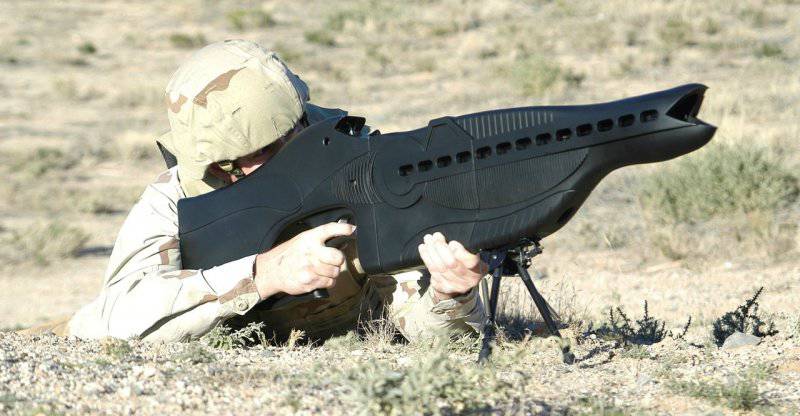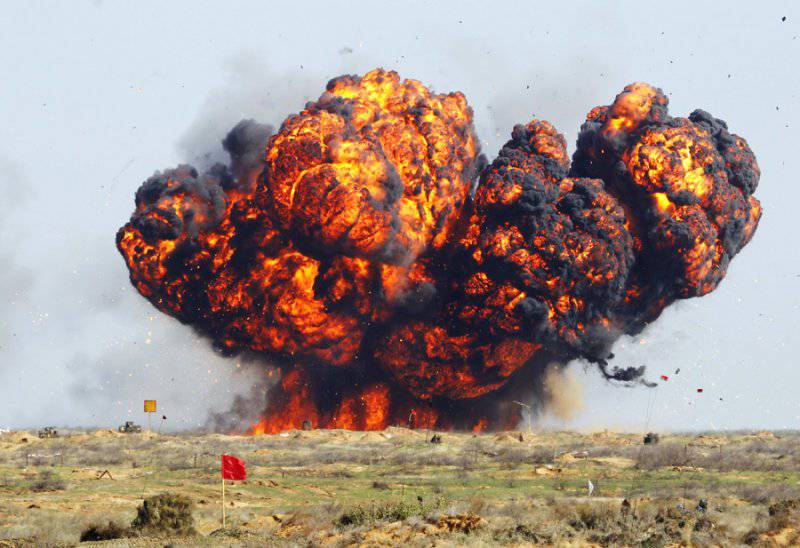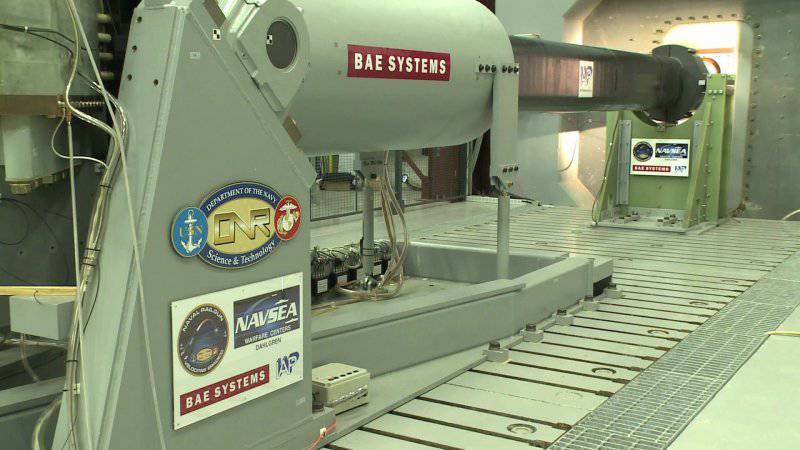Some ideas for improving small arms and artillery weapons
In recent years, a large number of various proposals have appeared regarding the improvement of ammunition for small arms and artillery weapons. Their authors appeal to the fact that the characteristics of existing propellant systems no longer significantly improve the capabilities of weapons. In this regard, it is proposed to create new types of propellant mixtures, ammunition and warheads, in which not yet mastered technologies will be used.
Pneumatic electric weapon
To some extent, interesting, although not unambiguous, is the so-called. pneumoelectric ammunition. The structure of such a cartridge or projectile is quite simple. A burning element made of carbon, metal or any other material with suitable characteristics is placed in the sleeve of the ammunition. In addition, the volume of the sleeve is filled with oxygen. In a dulce case, as in the case of conventional ammunition, placed missile projectile. Pneumatic electric ammunition, as their name implies, should use an electrical ignition system. It is understood that the current applied to the burning element, provokes its burning. Thus, a chemical reaction must occur inside the liner, which will result in the release of a certain amount of gas and heat. Being locked in the volume of the liner, the gas should push a bullet or projectile out of the barrel. In addition, in the sleeve may be a mixture of oxygen with an inert gas. The latter, heating and expanding, is able to improve the characteristics of the weapon.
There are several arguments in favor of pneumoelectric systems. According to supporters of this idea, the use of a metal-oxygen pair makes it possible to achieve a higher specific heat of combustion and, as a consequence, release more energy in comparison with existing gunpowder. The second argument concerns the use of an electric igniter, which to some extent simplifies the design of the weapon. Electrical equipment allows not only to abandon the usual trigger mechanisms, but also from the vapor or other automation. Electromechanical elements will also allow you to adjust various parameters of the weapon.
The advantages of pneumoelectric systems look impressive, but such ammunition still does not exist even in the form of experimental samples. The fact is that, apart from a number of advantages, this concept has a solid list of drawbacks. First of all, it is the need to use electrical systems. A current source, conversion equipment, etc. is required. Pneumatic electric weapons, suitable for use in the army, should receive appropriate insulation. Otherwise, the machine gun or weapon will work literally until the first puddle. Modern cannon weapons systems using traditional gunpowder are much less susceptible to water.
To create a practically applicable pneumoelectric ammunition and weapons under it will have to spend a lot of time researching in materials science, chemistry and physics. The material of the burning element must be chosen so that when it is burned, the maximum possible amount of energy is released in oxygen. This question is further complicated by the fact that a new pneumoelectric weapon must have higher characteristics than an existing firearm. Otherwise, it will not be able to interest potential operators.
The issue of materials relates to the design of weapons. It cannot be ruled out that along with the gaseous products of combustion, some amount of oxygen that has not entered into the barrel will get into the barrel from the sleeve. In combination with the high temperature of the gases, this can cause damage to the barrel. Thus, it will require not only an accurate calculation of the amount of gas inside the liner, but also some kind of coating of the bore that protects the metal from aggressive effects.
The use of stem coatings is mandatory for another reason. When firing in the barrel of a pneumatic electric weapon, as is the case with gunshot powder systems, carbon deposits will be formed. However, in this case, a large amount of oxide particles of the used metal will be present in the deposit. When accumulated in the barrel, such a deposit can lead to damage to the barrel and missile projectile, which will affect the survivability and other characteristics of the weapon.
The concept of pneumoelectric ammunition and weapons for him looks quite interesting. In theory, it can significantly improve the characteristics of small arms and artillery guns. However, to create even an experimental system of this class it is necessary to solve several complex issues related to the various features of the concept. At the same time, the solution of these issues will lead to the appearance of weapons, suitable only for testing ideas in the conditions of the landfill. Successful competition with classic firearms requires further development of new systems, which will be associated with additional difficulties.
As a result, it turns out that the complexity of implementing a new idea completely eliminates all the advantages promised by it. For this reason, in the foreseeable future, pneumoelectric weapons are unlikely to appear even in the form of experimental samples. So over the next few years, the new concept of weapons will be of interest to only a small number of researchers.
Metal hydride ammunition
In modern ammunition, various explosives are used, most of which appeared quite a long time ago. A significant increase in power is possible only with the use of special nuclear warheads. Nevertheless, such weapons have some peculiarities of a legal nature, and the specificity of the use of tactical nuclear weapons affects their effectiveness. An alternative to existing nuclear and conventional ammunition can be projectiles or bombs that use metal compounds with hydrogen.
One of the main supporters of weapons based on metal hydrides is inventor A. Golodyaev. He developed several types of ammunition of this class, some of which received patents. The main element of these munitions are substances with a high content of hydrogen, such as aluminum hydride AlH3. The latter contains about 10% of hydrogen by weight, and when heated above 105 ° C it decomposes into metallic aluminum and gaseous hydrogen. These properties are proposed to be used in ammunition.
As an example of the works of A. Golodyaev, one can consider the construction described in the patent “A device made of metal hydride for ammunition” (RU 2463283). The proposed warhead has a spherical shape with a hollow body. An initiating charge should be placed on the inner surface of the body - a layer of TNT with cumulative grooves and a metal lining. Each of the grooves is equipped with its own fuse. All fuses of the grooves are associated with the central one, which is responsible for the simultaneous detonation of the entire initiating charge. The inner surface of the initiating charge is associated with a layer of degradable material, namely metal hydride. The patent mentions the possibility of using beryllium tetrahydroborate (Be (ВН4) 2), aluminum hydride or other metal compounds with hydrogen.
The principle of operation of this warhead is as follows. The central fuse commands the simultaneous operation of other fuses, due to which the initiating charge, which has a large number of cumulative recesses, is undermined. As a result of this explosion, several shock nuclei are formed, moving towards the center of the spherical ammunition. Due to the explosion and the formation of shock nuclei in the center of the munition, the temperature and pressure rise sharply, which should lead to a rapid decomposition of the hydride into metal and hydrogen gas.
In the patent for "The device of metal hydride for ammunition," theoretical calculations of the characteristics of the prospective ammunition are given, as well as their comparison with traditional systems. Thus, it is stated that the explosion of one kilogram of TNT produces 3 thousand liters of gases. In the decomposition of beryllium tetrahydroborate, according to Golodyaev’s calculations, about 243500 liters of gas should be formed, i.e. 81 times more than in the case of TNT.
The inventor believes that the use of metal hydrides makes it possible to create promising ammunition, the power of which is tens of times higher than the corresponding characteristics of existing ones. Thus, a grenade for an AGS-30 automatic grenade launcher equipped with 100 grams of Be (BH4) 2 substance can have the same effect on the target as a projectile with an eight-kilogram TNT charge. A similar interaction of an initiating charge made of "traditional" explosives and decomposing hydride can be used in high-explosive fragmentation ammunition of various classes: in hand grenades, artillery shells, aviation bombs, etc.
Yet the proposal is not without serious flaws that can put an end to its future fate. The fact is that the prospects of warheads based on metal compounds and hydrogen are directly related to the capabilities of the existing explosives. The blast energy of the initiating charge, as is clear from the available information, is sufficient to decompose the active substance into metal and hydrogen. However, the pressure of the formed hydrogen may be insufficient for the formation of a shock wave whose power will be comparable to the force of the explosion of TNT, which initiates a chemical reaction.
To increase the pressure, hydrogen needs to transfer some energy. The source of this energy is the initiating charge, which, among other things, can to a certain extent heat the resulting gas. The explosion energy of the initiating charge is spent on the formation of shock nuclei, as well as on the heating and decomposition of the hydride. In addition, a large part of the energy goes to the formation of a shock wave that goes into the surrounding space. Only a small fraction of the energy remains to heat the gas produced. It is not difficult to guess what the effect of such a distribution of energy will be.
Patent RU 2463283 provides a calculation of the volume of gas emitted. According to him, when the hydrogen released from one kilogram of beryllium tetrahydroborate is heated to a temperature of 10000 ° C, its volume will reach 243,5 cubic meter. However, there is every reason to doubt that the initiating charge can heat the hydrogen to such temperatures. The real heating of hydrogen is unlikely to count on a noticeable superiority of the original warhead over systems using only TNT.
In addition, the actual capabilities of the original ammunition with metal hydride says its very structure. The hydrogen released by the reaction is only a working medium designed to affect the target. The source of energy in such a warhead is only the initiating explosive charge. Elementary logic suggests that in this case the power of the explosion, even taking into account the release of hydrogen, can not exceed the power of the initiating charge.
In order to justify projectiles with metal hydrides, it should be said that they can find their niche. When mixed with oxygen in the air, hydrogen forms a so-called. explosive gas. Hydrogen is able to burn in an oxygen atmosphere in a fairly wide range of concentrations. A small spark is enough to ignite hydrogen, and it can also detonate. The heat of combustion of hydrogen reaches 120-140 MJ / kg. Due to these properties, metal hydride munitions can combine the properties of high-explosive and incendiary. At the same time, however, their scope of application will be narrow and they are unlikely to be able to noticeably press "traditional" high-explosive fragmentation or incendiary ammunition.
Weapons of the future
Pneumatic electric weapons and metal hydride ammunition are of some interest. However, some features of these concepts do not allow us to talk about the possibility of their application in practice. In addition to the proposals described, there are many other original ideas that their authors believe can increase the combat power of armies. However, on closer examination, they also turn out to be too complicated or fundamentally unsuitable for use.
It should be noted that not all new ideas can be considered projectors. Some of them were able to interest scientists and the military, and particularly successful even managed to reach the stage of testing experimental samples. For example, there are already existing models of combat lasers or rail guns, which, after certain modifications, can be used as a full-fledged weapon. According to their characteristics, the existing models of promising weapons have become equal to the “traditional” systems or even bypassed them. For example, the rail gun company BAE Systems after debugging will be able to send a projectile at a distance of at least 150-170 kilometers. By the end of the decade, the muzzle energy of such systems should reach 50 MJ.
As we see, the weapon of the future already exists, although it is still on trial and is still far from practical application. Nevertheless, the recent successes of science and technology allow us to speak of further trends in the development of armaments. Apparently, it is lasers and rail guns that in the coming decades will try to replace the usual rifle and artillery systems. At least, they have already passed the stage of theoretical calculations and went from the drawings to the landfills.
On the materials of the sites:
http://n-t.ru/
http://findpatent.ru/
http://ihed.ras.ru/
http://popmech.ru/
More information about pneumoelectric weapons:
http://n-t.ru/tp/ts/oo.htm
Patent RU 2463283:
http://www.findpatent.ru/patent/246/2463283.html



Information